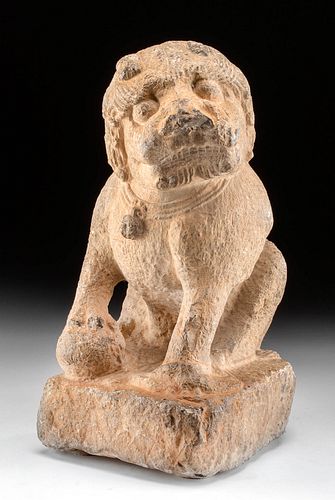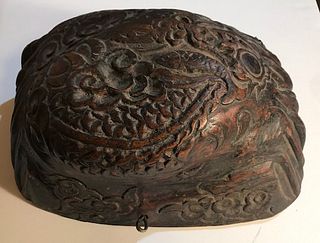Chinese Qing Dynasty Stone Fu Lion - "Foo Dog"
Lot 92b
About Seller
Artemis Gallery
686 S Taylor Ave, Ste 106
Louisville, CO 80027
United States
Selling antiquities, ancient and ethnographic art online since 1993, Artemis Gallery specializes in Classical Antiquities (Egyptian, Greek, Roman, Near Eastern), Asian, Pre-Columbian, African / Tribal / Oceanographic art. Our extensive inventory includes pottery, stone, metal, wood, glass and textil...Read more
Categories
Estimate:
$2,400 - $3,600
Absentee vs Live bid
Two ways to bid:
- Leave a max absentee bid and the platform will bid on your behalf up to your maximum bid during the live auction.
- Bid live during the auction and your bids will be submitted real-time to the auctioneer.
Bid Increments
| Price | Bid Increment |
|---|---|
| $0 | $25 |
| $300 | $50 |
| $1,000 | $100 |
| $2,000 | $250 |
| $5,000 | $500 |
| $10,000 | $1,000 |
| $20,000 | $2,500 |
| $50,000 | $5,000 |
| $100,000 | $10,000 |
| $200,000 | $20,000 |
About Auction
By Artemis Gallery
Aug 27, 2020
Set Reminder
2020-08-27 10:00:00
2020-08-27 10:00:00
America/New_York
Bidsquare
Bidsquare : VARIETY SALE | Antiquities & Ethnographic Art
https://www.bidsquare.com/auctions/artemis-gallery/variety-sale-antiquities-ethnographic-art-5477
Around the world & back in time - be amazed at the treasures you will find. Antiquities from Egypt, Greece, Italy and the Near East, Asian, Pre-Columbian, African / Tribal / Oceanic, Native American, Spanish Colonial, Russian Icons, Fine Art, much more! Artemis Gallery info@artemisgallery.com
Around the world & back in time - be amazed at the treasures you will find. Antiquities from Egypt, Greece, Italy and the Near East, Asian, Pre-Columbian, African / Tribal / Oceanic, Native American, Spanish Colonial, Russian Icons, Fine Art, much more! Artemis Gallery info@artemisgallery.com
- Lot Description
East Asia, China, Qing Dynasty, ca. 1644 to 1912 CE. An imposing stone carving of a fu lion, or "foo dog", on an integral stone plinth. Sitting upon his haunches, the long tail winds around his front paw, the other paw rests on a ball. An ornamental bell collar sits on the neck, a swirling mane, and knobby ears adorn his tilted head. Bulging eyes stare from under the mane above a squared snout, snarling to reveal teeth and a chin with curled hair. A highly stylized representation of a lion guardian that protected sacred buildings against evil spirits or people. Lions had been brought to Chinese courts as early as the Han dynasty, but most artists relied on second-hand sources for descriptions, resulting in very stylized figures, often mistaken as dogs by western viewers. Size: 5.75" W x 11.75" H (14.6 cm x 29.8 cm)
The "foo dog" is a western name for the Chinese "shi shi", the guardian lion. A common architectural protective figure originating in Imperial China that spread into many Asian cultures. Often portrayed in a pair with a male and female to represent Yin and Yang. The male, such as this piece, plays with a ball and the female plays with a cub.
Provenance: private Boulder, Colorado, USA collection, ex-Indochine Gallery, Colorado acquired in 1998.
All items legal to buy/sell under U.S. Statute covering cultural patrimony Code 2600, CHAPTER 14, and are guaranteed to be as described or your money back.
A Certificate of Authenticity will accompany all winning bids.
We ship worldwide and handle all shipping in-house for your convenience.
#157502Surface weathering and softening of finer details. Losses as shown to paw and leg. Nice earthen encrustations and patina.Condition
- Shipping Info
-
All shipping is handled in-house for your convenience. Your invoice from Artemis Gallery will include shipping calculation instructions. If in doubt, please inquire BEFORE bidding for estimated shipping costs for individual items.
-
- Buyer's Premium



 EUR
EUR CAD
CAD AUD
AUD GBP
GBP MXN
MXN HKD
HKD CNY
CNY MYR
MYR SEK
SEK SGD
SGD CHF
CHF THB
THB
















